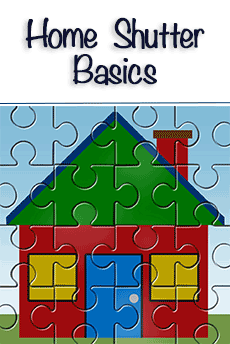 The best shutters are those that combine functionality, endurance and design, but what came first – the window or the shutter? It’s a good question, although it must be the window, otherwise why invent shutters?
The best shutters are those that combine functionality, endurance and design, but what came first – the window or the shutter? It’s a good question, although it must be the window, otherwise why invent shutters?
However, much depends on your definition of a window, because shutters were originally used to cover up ventilation holes in the walls of early houses. They were eventually superseded by glass paned windows, and then used at night to protect the glass and prevent people breaking in.
Early shutters were closed from the inside, unlike today when they are used more for decoration than their functional use. However, the new breed of slatted or louvered shutters is functional, being used just as venetian blinds are to control the amount of light and air entering the room.
Plantation Shutters
Also known as slatted or louvered shutters as explained above, the angle of the slats can be adjusted to control the light entering a room. Some regard these as the best shutters for the modern home since they are available in a wide range of sizes. That can be use for full-sized patio doors or for regular windows, and are available in a range of colors.
If you are choosing shutters for their functional as well as decorative properties, plantation shutters are ideal. They can be closed to completely block off the light, just like regular blinds, or opened fully when desired. Because of the variety of colors and sizes, these are suitable for practically any type of window and home décor.
Board Paneled Shutters
Board or paneled shutters are solid and cover the entire window when closed. Many modern types are designed as external forms of window decoration, hinged back each side of the window. They are usually painted to match the exterior décor of the building. While the original versions of these were fixed inside the house, and closed from the inside, they later became fixed outside although for convenience were still closed and latched from the inside via the open window.
Now they are either permanently fixed externally, or are functional and can be closed from the outside. The best designs for small windows are in the form of a single panel, hinged to one side of the widow only. Board shutters are best for New England and the north-eastern states.
Cafe Shutters
When choosing shutters, some people prefer what are referred to as café shutters – they fit only the lower half the window. This prevents the casual passer-by from looking in while permitting light to enter from the top half. Another form is the tier-on-tier style, when the top and bottom halves are hinged separately. This allows the traditional appearance, but with the benefit of the café design. Along with the plantation style, these are good for the southern states where the top half can be left open to allow air movement.
Choosing the Best Shutters
The best shutters for your room will depend on the style you want, your décor and the direction your window is facing. External decorative shutters should match your exterior color scheme or color of the wall and window frame. Internal plantation types tend to be white to match the patio doors. However, don’t be afraid to try out different contrasting colors.
Other forms of internal shutters should suit the window frame and the internal décor. If your woodwork or floor is dark, then white or a light color will help brighten the room. The same is true of a north-facing window – light colors tend to brighten up the room. Popular colors for exterior styles are black, red and white
The best shutters are fixed authentically, with hinges and proper hardware such as shutter dogs. False types that are screwed to the wall look cheap. They should also be wide and high enough to completely cover your windows. When choosing shutters, consider their use, décor and location. Use louvered or café shutters in hotter climates and board styles in the north. The correct choice can add value to your home.


About The Author: Karengustin
More posts by karengustin